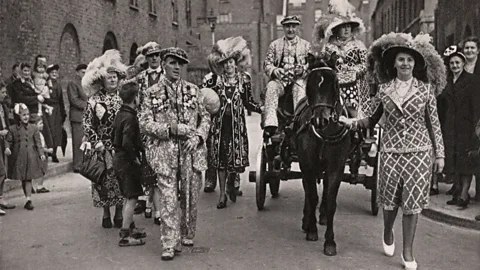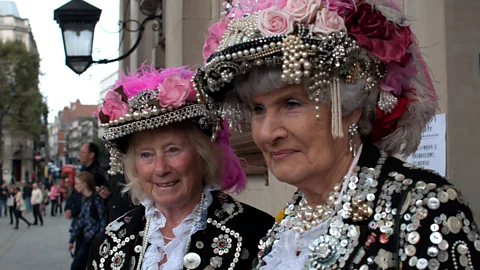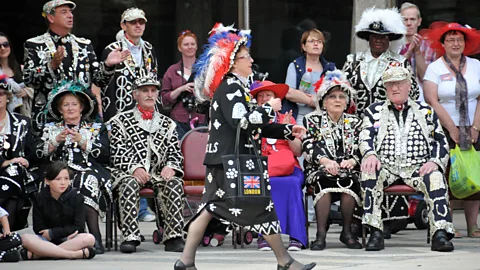The pearly kings and queens: London's 'other' royal family
 Nicole Cubbidge/Alamy
Nicole Cubbidge/AlamyOriginating in 19th-Century Victorian England, the pearly kings and queens have become icons of London life and maintain a lifelong commitment to raise money for charity.
In jet-black suits encrusted with mother-of-pearl buttons, a troop of "pearlies" wended their way among the sombre thousands gathering in memory of Queen Elizabeth II. They left a bouquet in reverence of the late monarch, with whom they shared the same strong sense of duty. Towards The Mall, a street between Buckingham Palace and Trafalgar Square, a husband and wife in suits beaded like silver scales waited patiently. "I've always loved the Queen," said Jimmy Jukes, in a broad, rolling voice, "She has been there ever since I was born."
And the Queen held Jukes in high esteem too. In 2017, he was given an MBE for his charity work as the Pearly King of Bermondsey, Camberwell and Southwark. Along with his wife, Michelle, Pearly Queen of Bermondsey and Rotherhithe, the pair are just two of London's pearlies.
With a royal title for every London borough, it's thought there are around 30 pearly families today, each dedicated to fundraising for charitable causes. They are icons of London – a fixture both at the capital's large-scale events as well as tight-knit community affairs – and they maintain a lifelong commitment to meeting and greeting the public and visiting hospices, schools and community groups throughout the capital. Over 150 years, they've become a part of the city's psyche, written into British culture, from pop songs to album covers and TV appearances. While they're little known outside the country, they are considered London's "other royals".
"Cockney royals," Jukes said proudly.
 Richard Slater/Alamy
Richard Slater/AlamyIn London lore, to be considered cockney you must've been born within earshot of the bells of St Mary-le-Bow church in East London – but 170 years ago lower noise pollution meant their toll could be heard as far as North London, too. Cockney culture was inextricably bound with costermongers ("coster" for apple, and "monger" for seller) – roving vendors who were a fixture of working-class Victorian London.
Dickensian characters, female costers cheekily wore tit for tat ("hats" in Cockney rhyming slang) mimicking the well-to-do; while men would sew mother-of-pearl buttons (cut from the lining of a mollusc shell) along the seams of their garments, shouting sales patter, poems and melodies as they hawked their wares in baskets or pony-drawn carts to the capital's borough markets.
But they were outspoken when it came to the politics of poverty that they were desperately trapped in. They survived by crowning a symbolic "king and queen", who was sworn in to protect the interests of the market vendors, them financially through hard periods and keep an eye out for trouble with the "old bill", as they called the police.
In the mid to late 1870s, Henry Croft, an impoverished Victorian road sweeper, was so inspired by the community-mindedness of the costermongers that he decided to transform himself into the very first "pearly" – so called for his majestic suit decorated with 60,000 iridescent mother-of-pearl buttons.
 Chronicle/Alamy
Chronicle/AlamyCroft got his brilliant idea when he was sweeping up after the costermonger markets in Somers Town, an inner-city district in North-West London. "He liked this idea of camaraderie and the community values," explained Diane Gould, the Pearly Queen of St Pancras. "The costermonger attitude to life was never kick a person when they're down, as they were all working-class people, all struggling to survive."
He decided to not only emulate, but go one better than the costermongers, embroidering mother-of-pearl buttons across every inch of his battered work wear. In his new finery that glinted in the sunlight, Croft discovered he attracted attention – and coins – from ers-by wherever he went. By 1911, he'd gathered up the working-class communities and elected 28 pearly families, one for each London borough, forming a charitable tradition that survives to this day.
When I met Gould, she was fitted out in full pearly regalia, which remains similar to Croft's original designs. For men, this includes a button-adorned flat cap; while women sport a cartwheel-style felt hat crowned with 13 ostrich feathers. Every pearly wears a black suit with their borough's name spelt out in large lettering. They might opt for a less-embellished "skeleton" design or a fully encrusted "smother" suit (that can weigh up to 30kg), but each is threaded with a dazzling array of mother-of-pearl buttons.
All pearly uniforms feature of constellation of symbols that represent their values: embroidered hearts symbolise charity, for example, while a wheel is the symbol of life, a donkey represents costermongers and, a horseshoe spells good luck. "Traditionally, pearly families kept similar designs on their suits," said Gould, pointing to her blazer's harlequin diamond pattern, calling it "the ups-and-downs in life". She added: "It's all about telling our story in buttons."
 Colin Underhill/Alamy
Colin Underhill/AlamyGould was born in Somers Town and grew up among market traders in Islington. Coming from a long line of pearly royalty, Gould's title was a blood birthright, as per traditional pearly decree. Her father, the infamous Alf Dole, was known for his rat-tat-tat-tat spoon playing and whizzing around Greenwich in his elaborate button-decorated black cab. Her great grandfather, George Dole, "was Henry Croft's china plate (mate)," she told me. As for many pearlies, living in her elected borough is no longer practical due to the capital's gentrification, but the cockney tradition of stories about hop picking holidays in the British countryside and sing-alongs down at the battle cruiser (boozer) have travelled with her.
Cockney Rhyming Slang
Rosy lee: Tea
Dustbin lids: Kids
Round the houses: Tros
China plate: Mate
Billy bunter: Punter
Jack Palance: Dance
Cherry hogg: Dog
Pig's ear: Beer
Battle cruiser: Boozer
Old oak: Smoke
Loaf of bread: Head
Weeping willow: Pillow
Ball of chalk: Walk
Mince pies: Eyes
North and south: Mouth
Lilian fish: Dish
"I took my loaf (head) off the weepin (pillow). I got out my uncle (bed)," she rhymed in traditional pearly lyricism, which is derived from cockney dialect and coster backslang (a language used to secretly share information without pricking ears of police or ers-by). "Daisy roots are boots, barefoot blues are shoes, almond rocks are socks," she pealed into laughter, delighting in sharing her history.
But while the history of the pearlies, which is a story of working-class values and activism, is deeply important, the kings and queens are equally concerned with how to best keep their traditions alive and relevant in the 21st Century. As with the Windsor royal family, there are differing opinions as to whether the institution should be modernised.
"In 1930, there were 400 pearlies. But today there are two handfuls of genuine pearlies left, not including my family of 30," said George Major, Pearly King of Peckham and founder of the Original Cockney Museum. In his teenage years, Major noticed he was attending more funerals than he saw "dustbin lids" (kids) interested in continuing their parents' royal roles.
To combat these dwindling numbers, of the general public can apply to become "independent royals" through organisations such as the Original Pearly Kings & Queens Association and the London Pearly Kings and Queens Society. Each organisation shares a commitment to community service with fundraising at their core, and assesses applicants based on their charitable credentials.
Doreen Golding, Pearly Queen of the Old Kent Road and Bow Bells, wasn't born a pearly, but as chairman of London Pearly Kings and Queens Society, she has dedicated herself to being one. She's often found fundraising on the streets or ing the public at large-scale events. "We are not fabulously rich, like the royal family," she laughed. "We do it to help others at our own expense."
 Matthew Chattle/Alamy
Matthew Chattle/AlamyShe has fond memories from throughout her reign, but one moment stands out. "We were leaving the Chelsea Flower Show once, when a very familiar voice with an American twang called out and said, 'Could I have a photograph with you? You're the best-dressed person here'," Golding said. "It was Ringo Starr."
The Pearlies' impeccable dress is partially why they've remained fundraising titans. "Pearlies will help any charity out if it's within their realms and beliefs," Jukes explained. He and Michelle founded UK Homes for Heroes. "It's designed to help homeless ex-service personnel who fought for our country," he said, describing the mental health services and housing they offer. When a pearly is behind a charity, they know exactly how to drum up public . "How much we've raised is like asking 'how long is a piece of string">window._taboola = window._taboola || []; _taboola.push({ mode: 'alternating-thumbnails-a', container: 'taboola-below-article', placement: 'Below Article', target_type: 'mix' });
